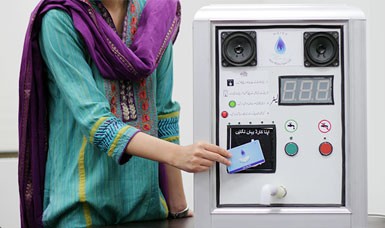Pakistan’s goal is to bring clean water to more than 35 million people in the next two years, and they will soon pilot a unique technology to get them there.
It’s called a Water ATM (Automated Water Dispensing Machine), and like the ones we use at banks, you just swipe your smart card – but instead of dispensing cash, water comes out of a faucet. Push a button and water starts flowing, push another button and it stops.
Solar-powered and equipped with sensors that measure how much water is available, and a meter that manages how much comes out, the government can track the amount and quality of water dispensed each day in real time, online. The ATM will draw from a water filtration plant below.
Besides giving people a daily ration of clean water, the ATM makes sure none is wasted.

The pilot is expected to benefit 17,500 families who will be allowed to take up to 30 liters of water per day. While the water will be free of charge, communities will pool the money needed to pay for maintenance each month.
A local research organization, Innovations for Poverty Alleviation Lab, developed the ATM and is working with state-owned Punjab Saaf Pani Company (which stands for Clean Water) on implementation.
While the pilot will be in Pakistan’s most populous province, Punjab, where 98 million people live and water shortages are a way of life, nearly 14 million people have no choice but to collect contaminated water. Resulting diseases cost the government over $1 billion a year, and with more people moving into urban areas, it is straining what little capacity there is.
The government of Punjab is spending $200 million on the program, says Muhammad Farasat Iqbal, CEO of of Punjab Saaf Pani Company. Apparently, a similar card-based water dispensing system is in use in India.
Big Solar Too
Not only does Pakistan have severe water shortages, it lacks electricity too – affecting more than a third of the people who live there.
Also in Punjab, the 300 megawatt Quaid-e-Azam solar plant comes online later this year.
"Tackling our energy crisis is the top priority of the present government as we believe it is vital in order to achieve economic growth, alleviate poverty, boost agricultural and industrial production and – through the provision of clean, solar power – reduce the country’s carbon footprint," Mushahidullah Khan, Federal Minister for Climate Change, told Climate News Network.
Built by China’s Tebian Electric Apparatus Stock Company, this is the first of many solar and wind projects he says. China may invest over $30 billion in renewable energy projects in Pakistan, as it forges close economic links to gain access to the Arabian Sea.
Read our article, Pakistan Breaks Ground On One of the World’s Largest Solar Parks.

I dont know how this project will work successfully because Punjab Government of Pakistan is very fond of starting fancy projects without taking into consideration , the education level and living conditions of citizens. This ATM water is just another project like yellow cabs, green tractor, sasti roti and on and on. Rest assure this will also fail because those who proposed and who approved will make their money and commission and go. If present Punjab set which is in power for 30 years can not provide basic medical facilities, if the public school system in in shambles, if people dont have LPG and Electricity to cook their food and if public transport is expensive and pathetic, then this ATM water is of no use.
Look on the bright side. If of all that is not available, at least this most fundamental of need is attempted to being met. Pitch in!
In my opinion this is the beginning of the water war https://www.patriotdirect.org/water-atm/